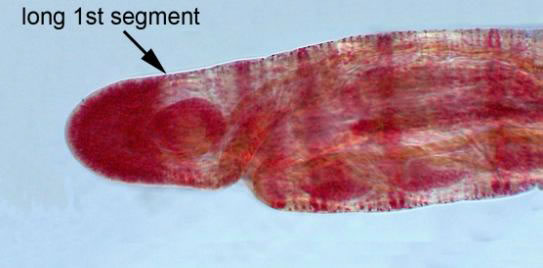Phylum Annelida
Class Clitellata
Family Haplotaxidae
Common names: haplotaxids
Overview
The Haplotaxidae is a family of mostly aquatic oligochaetes, superficially resembling earthworms. Most species are 2-10cm long, and are very elongate relative to their width. Often haplotaxids have pink or brown colouration when alive.
Distribution and diversity
There are only about 20 species of Haplotaxidae described worldwide, all from the type genus, Haplotaxis. Four species have been reported from Australia. Only one species, Haplotaxis ornamentus, is endemic to Australia and has been described from deep Tasmanian lakes. The rest of Australia�s species have been identified from very few specimens.
Life cycle
Haplotaxids, like all oligochaetes, are hermaphrodites, with both male and female genitalia. A mating pair overlaps anterior ends ventrally and each exchanges sperm with the other. The worms then separate and the clitellum secretes the cocoon that forms a ring around the worm into which the eggs are laid and sperm deposited.
Feeding
The genus Haplotaxis, including Haplotaxis heterogyne which was described from New Zealand, is predatory and the animals have a gizzard-like pharynx and large sickle-shaped ventral chaetae for grasping prey.
Ecology
Most species of Haplotaxidae are found in semi-terrestrial habitats such as river banks or in surficial sediments of lakes and streams. They also inhabit subterranean environments such as caves, groundwater and hyproheric zones (where groundwater and surface water meet).

Haplotaxis sp. head
Image credit: � Adrian Pinder, used with permission

Haplotaxis sp., image of the hooked ventral chaetae
Image credit: � Adrian Pinder, used with permission








